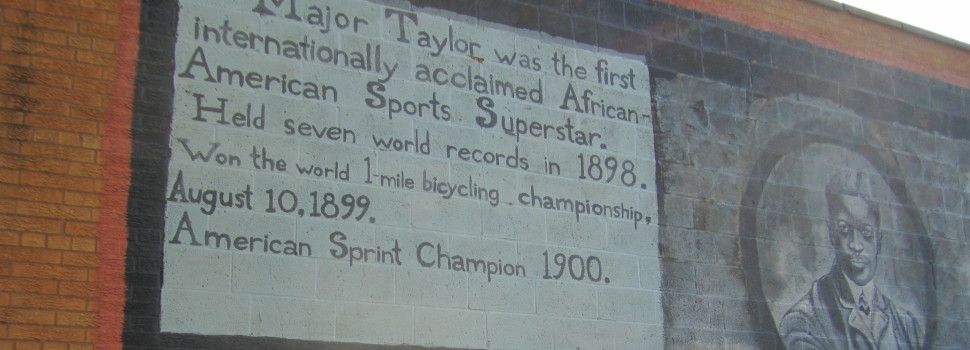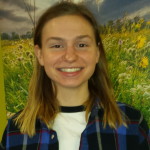
Spending a few hours regularly to volunteer at the Dan Ryan Woods is a great idea, too. Not every community has such a natural jewel.
By Douglas Chien, Powderhorn Site Steward
Contained within Powderhorn Lake Forest Preserve is a very special and rare place, a place with an exciting ecological restoration project happening soon. A project that myself and a team of volunteers have worked towards for the past 10-years.
Powderhorn Prairie Nature Preserve is the only Illinois Nature Preserve within the City of Chicago and is a rare dune and swale ecosystem; low sand dunes separated by wetlands. Dune and swale once covered much of the southern end of Lake Michigan before European settlement and subsequent industrialization. At Powderhorn, you can experience a landscape utilized by Native Americans but then seen as wasteland by later residents. Today, one can stand on a dune and be in a high quality sand prairie then walk 20’ and be knee deep in a high quality wetland.
Along the first sand dune, past soil disturbance, the absence of ecological stewardship, and especially the lack of prescribed fire, allowed eastern cottonwood trees (Populus deltoides) to get established and grow to maturity. With a canopy of large cottonwood trees, the once rich layer of grasses, sedges, and flowers died out. Fortunately the remaining six sand ridges remained healthy and continue to provide homes for a variety of insects, butterflies, and other animals.
Thanks to support from the National Oceanic and Atmospheric Administration and the Illinois Department of Natural Resources’ Coastal Management Program about 300 large cottonwood trees will be cut down. With proper structure restored, the area will be seeded with flowers, grasses and sedges collected on site. Over the next several years we expect to see a healthy mix of native plants and corresponding wildlife return. We’ll also be vigilant about stopping invasive plants from gaining command of the area.
This is a highly visible project as the area being cleared is along Brainard Ave. A well traveled route between Indiana and the Hegewisch neighborhood. The Forest Preserves of Cook County have been a valuable partner in this project, providing technical support and additional funding.
Volunteer stewardship days are the 3rd Saturday of the month from 9 am till Noon. Drop me a line if you’ve any questions or would like to come out and help. Special thanks to my fellow Site Steward Alice and our regular crew: Matt, Jay, Oliver, Tom, and Nik.
dskchien@sbcglobal.net
Friends of the Forest Preserves number more than 3,000 committed volunteers and members, but more are always welcome to join.
A new bike path connecting 31st Street and 26th Street along First Ave./ Golfview Ave. will be completed in 2016.
It all started with a stuffed polar bear. That is how my journey as an environmentalist began. It was gifted to me as a child and I still have it to this day. I became so attached to that stuffed polar bear that I remember watching those commercials about dying polar bears on melting icebergs and feeling like I personally needed to save my stuffed polar bear. But it was later when I took Environmental Science in high school that my love for the environment really took off. I remember collecting data on crawfish and exploring prairies during our field trips. It was during that time that the enormity of our planet’s environmental problems hit me. The sense of doom that a lot of us who care about protecting the environment feel became real to me in high school. I knew at that point that whatever I would end up studying in college and later pursuing as a career would revolve around protecting the environment.
Growing up in Lemont I also had access to a lot of Cook County’s forest preserves. Exploring the forests and going camping in Wisconsin became a pastime of mine. All this greatly shaped the goals and dreams of my life, but it was when I studied Sustainable Development in India that my day to day really changed. Living in a culture that wasted so little has affected my trash output enormously. Now I am very conscious of all the trash I produce and try to be intentional about using reusable cups and bottles. Buying secondhand clothing and eating less dairy have also become habits of mine. Currently, as the Research and Office Management Intern for Friends of the Forest Preserves, I have gotten the opportunity to interact with nature within the city’s limits. I am more than thrilled to continue my journey of exploration and curiosity as an environmentalist for the rest of my life.
 By: Kathy Machaj, Research and Office Management Intern
By: Kathy Machaj, Research and Office Management Intern
One century ago this year, the University of Illinois at Urbana-Champaign launched its flagship outreach effort in the form of the Extension School (you can learn more about its history here). Today, Extension offers educational programs in all of Illinois’ 102 counties. Coincidentally, the school shares its centennial anniversary with none other than the Forest Preserves of Cook County. Yet a connection was not forged between the two until very recently—last year, to be exact.
The inaugural Master Naturalist program was established close to U of I’s homebase in central Illinois in 2005. Then and now, it covers Champaign, Ford, Iroquois, and Vermilion Counties, as well as the Champaign County Forest Preserves and Urbana Park District. The program promotes nature-based community service by citizen volunteers. By providing participants with science-based educational opportunities, it better equips them to share natural resource information with the public and to become engaged and effective environmental stewards.
It took nearly a decade before the program was expanded to address the natural history, environment, and conservation issues of Cook County—despite that it’s home to the oldest and largest forest preserve district in the nation. In its recent history, of course, the forest preserves were subject to a great deal of abuse and neglect. Ancient prairies and woodlands had been replaced by impassible thickets of invasive brush, land had been sold off, and the landscape was dotted not with a diversity of species but with litter. Thousands of acres were protected, but few offered an ideal setting in which to learn about the county’s unique flora, fauna, and ecology.
The preserves have since made quite the comeback. Many sites have been restored under the careful guidance of dedicated stewards, volunteers, and even Friends’ own intern corps. Nearly 1,000 acres meet the Illinois Natural Area Inventory’s criteria for high-quality habitat. More than 1,200 species of native plants and 300 species of native birds thrive in the preserves. And 10,200 acres of lakes and ponds (not including Lake Michigan), 2,300 acres of swamps and marshes, and 576 miles of creeks and rivers host nearly 100 species of fish—not to mention a variety of other aquatic life (more information on the preserves’ natural and cultural resources, as well as how the District plans to manage them for the next century, can be found here).
And so, a mosaic of forest preserves ranging in condition from pristine to vulnerable spans the county. This variety of sites provide the ideal environment to train Master Naturalists—the latest class of which I was accepted into earlier this year. As we cover units such as mammals, reptiles, geology, hydrology, botany, archaeology, and the climate of Cook County, healthy and accessible sites represent the best-case forest preserve scenarios. We’re trained in restoration techniques for sites overrun with buckthorn, damaged by erosion, or encroached upon by development, but these sites also afford invaluable perspective.
Armed with the knowledge we gain from those preserves, and from the experts who work in them, the second class of Cook County Master Naturalists will be finishing the program at the end of October. Graduates will be equipped to conduct restoration work, lead students on field trips, and volunteer in a variety of capacities. We will be the latest in a long line—Friends’ included—of advocates for our forest preserves.
More information about the Cook County Master Naturalist program can be found at http://web.extension.illinois.edu/cook/mn/.
 By Catie Boehmer, Development Manager, Friends of the Forest Preserves
By Catie Boehmer, Development Manager, Friends of the Forest Preserves
Chicagoland’s conservation leaders represent a huge variety of organizations and causes whose efforts range from getting more people out on the Chicago River to promoting clean energy and environmentally sound policies. But they are also looking to the future in a new way: they’re looking for their successors.
Now in its second year, the Chicago Next Generation Environmental Leadership Initiative is focused on cultivating an up-and-coming cohort of young people who hope to eventually be at forefront of the conservation movement here. As a staff member at Friends, I was lucky enough to be nominated to participate in this experiment (this is, after all, only its second iteration).
The program is the brainchild of the Environmental Law and Policy Center’s executive director Howard Learner, and it’s an intentional effort to ensure we are well-positioned to take over for our predecessors when the time comes. The unique blend of education, professional development, and networking is unlike any course I’ve taken or industry mixer I’ve attended. And it already feels more productive.
My peers in the group hail from a not-so-surprising collection of local organizations, including Faith in Place, Alliance for the Great Lakes, the Environmental Law & Policy Center, Openlands, the National Parks Conservation Association, Elevate Energy, the Nature Conservancy, the Natural Resources Defense Council, and the Delta Institute. Our roles, career paths, and backgrounds, however, could not be more varied.
That is what makes this experience so rewarding. On an everyday basis, I learn a lot about what’s going on in the forest preserves—which sites our Conservation Corps are restoring, where new trails are being proposed, what species of sedge is making a comeback. Now, that influx of information has increased immeasurably. I have never felt more connected to Chicago’s conservation community—or better prepared to continue on this path.
 By Catie Boehmer, Development Manager, Friends of the Forest Preserves
By Catie Boehmer, Development Manager, Friends of the Forest Preserves
The Lakeside Heritage Walk on Chicago’s southeast side, made possible by a grant from the National Oceanic and Atmospheric Administration and the Illinois Coastal Management Program, is now complete. Sprinkled along the recreational walking path of Steelworkers Park at 87th Street and Lake Michigan, the permanent installation of eight educational trail signs brings to life the rich environmental and social history of South Chicago’s first lakefront park and the city’s first steel mill, South Works.
The six-foot tall Lakeside Heritage Walk signs illustrate the site’s cultural and industrial past as well as its redevelopment and emerging biodiversity—from its still-standing ore walls to its future as a thriving green community. The visually-engaging signs provide an opportunity for community members and students to learn about Chicago’s indelible industrial history and the evolution of the Lake Michigan shoreline.
“The Lakeside Heritage Walk will provide the skills, knowledge and inclination to understand what environmental and habitat improvements have been and will be made at the location’s redeveloped brownfields and industrial sites,” explains Benjamin Cox, president of Friends of the Forest Preserves, a collaborator on the project. “The trail will also protect and increase interconnected lakefront open space, which will be invaluable to the surrounding community and help make connections to forest preserve sites nearby.”
The Lakeside Heritage Walk is part of an ongoing initiative to transform the former industrial site into Lakeside—a LEED-certified, mixed-used community that will extend Chicago’s public lakefront corridor. Created through the collaboration of McCaffery Interests, United States Steel Corporation, Friends of the Forest Preserves, and Skidmore, Owings & Merrill, the Lakeside Heritage Walk will be a highlight of the 600-acre Lakeside community, a long-term joint venture between site developer, McCaffery Interests, and property owner, United States Steel Corporation.
For more information about the Lakeside Heritage Walk, visit LakesideHeritageWalk.org
About McCaffery Interests, Inc.:
McCaffery Interests, Inc., is a privately owned, full-service commercial real estate company that has been in the business of investing, developing, leasing and managing real estate for nearly 25 years. The McCaffery Interests portfolio of planned, completed and managed projects exceeds 20 million square feet and includes office, mixed-use, hotel, and residential properties, as well as large, master-planned communities and land developments. With offices in Chicago, IL and Washington, DC, and controlled assets and completed developments valued in excess of $2 billion, McCaffery Interests is one of the most trusted real estate companies in the nation. For more information, please visit www.mccafferyinterests.com.
About Lakeside:
A joint venture between McCaffery Interests and United States Steel Corporation, Lakeside presents a game-changing urban ideal not just for Chicago’s Southeast lakefront, but for the entire region. With visions for a new dynamic and diverse community, the site that was once America’s largest steel mill will transform into a compelling model for a green 21st century lifestyle. Estimated to be completed in 25 to 45 years, Lakeside’s vision for the nearly 600-acre site includes plans for a connected and accessible community, next generation infrastructure, innovative architecture and lakefront access, all surrounded by a vibrant mix of residential, retail and commercial space, a new high school and a 1,500 slip marina. ChicagoLakesideDevelopment.com
By TOM ROBB Journal & Topics Reporter
Elk Grove Village Mayor Craig Johnson stood on a bridge over the Busse Reservoir Dam spillway Wednesday, Aug. 12 surrounded by a host of senior state and county officials, mayors and engineers, cutting the ribbon on a major Salt Creek flood mitigation project, benefiting Elk Grove Village and DuPage County communities along Salt Creek.
On Monday, Aug. 17, construction equipment will come in to begin installing two massive 14,000-pound, 37-foot wide hinged curved stainless steel floodgates across spillways in the Busse Dam. The huge metal gates will be able to completely open or close in just 10 minutes and withstand a force of 1,500 pounds. per lineal foot. The project is expected to be completed by Thanksgiving, Johnson said.
“Nearly eight years ago, we began work on the Busse Dam Modification project with the lofty goal of bringing flood relief to the residents and businesses of this region.” Johnson said. “And now, thanks to the partnership, cooperation and support of numerous federal, state and local agencies, we are mere months away from achieving this goal.”
Of 40 measurable Salt Creek flood events, Johnson said 20 would not have happened had this project been in place and an additional 17 flood events would have had would just minimal impact in Elk Grove and along Salt Creek, leaving only three of the last 40 flood events having a major impact.
Johnson said the dam project is the first in Illinois to include major participation by two counties, Cook and DuPage and the largest single project the village has ever undertaken.
Dignitaries at the event joining Johnson atop the dam bridge included Cook County Board President Toni Preckwinkle, DuPage County President Dan Cronin, Metropolitan Water Reclamation District (MWRD) of Greater Chicago Board President Mariyana Spyropoulos, Illinois Dept. of Natural Resources Director Daniel Injerd, Cook County Forest Preserve Supt. Arnold Randall, Friends of the Cook County Forest Preserve Executive Director Benjamin Cox, mayors from Wood Dale, Itasca and Hanover Park, Elk Grove Village trustees and staffers and representatives from U.S. Rep. Tammy Duckworth (D-8th) and State Rep. Michelle Mussman (D-56th) offices.
Johnson was quick to thank the many political leaders and entities helping make the project possible since he first announced plans to modify the dam in the wake of the September 2008 storm and flood that left six northern Illinois counties, including Cook and DuPage federal disaster areas. Preckwinkle and Cronin also praised Johnson for his leadership on the project. The project has an expected total price tag of about $4.6 million with the village picking up $3.3 million of that cost, MWRD picking up $1.125 million and DuPage picking up $100,000 of those costs.
Johnson said a key moment in the process occurred last April in a meeting with Preckwinkle in her downtown Chicago office. Johnson said he was nervous, but said when he saw Cronin hug Preckwinkle, “I knew it was going to be OK.”
When Johnson first announced plans to install flood controls in the dam in 2008, before any engineering studies, influential environmental activists from the Friends of the Cook County expressed concern about rising water levels impact on the flora and fauna along the banks of Lake Busse.
Cox met with Johnson in late 2008 and early 2009. Through those meetings, Friends of the Forest Preserve brought in Northwestern University engineering students to come up with a plan to detain water using spillway controls in the dam that would regulate water levels in Lake Busse before and during a storm event to control flooding along Salt Creek.
At the ribbon cutting, Cox said the dam modifications would actually help the flora and fauna along the lake’s banks more than the current situation as the lake’s level fluctuates now with storm events bringing sediment into the lake. Once complete, the lake levels would remain much more constant.
That sentiment was echoed by Randall who said many come to the forest preserve district with plans for flood detention that are often rejected because their mandate is to do no harm to the forest preserve. This project actually helps it.